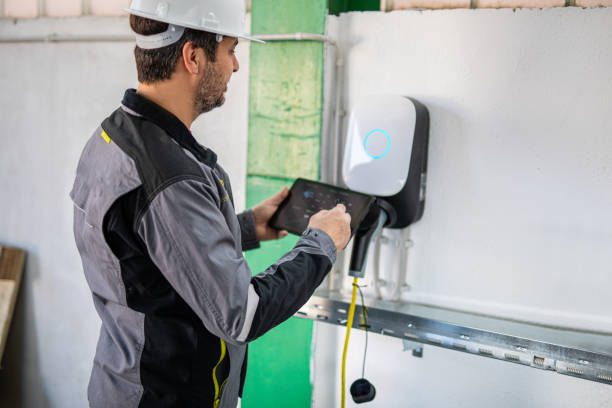Complete EV Charger Installation Checklist for Homeowners in Singapore

Electric cars now fill more roads in Singapore. More people pick clean, smart ways to travel each year. EV charger installation Singapore now plays a big role in this change. When you set up a charger at home, you skip long waits at public stations. With the right steps, you won’t face trouble or safety risks.
Why Prepare Before Installation
Getting ready saves time and trouble. If you skip steps or rush the process, you might face delays or safety risks.
Key Reasons to Plan:
- Avoid electrical overload
- Meet local rules
- Prevent damage to your home setup.
- Shorten approval time
Understand the Types of EV Chargers
Look at each charger type and grab the one that fits your life best. When you dig into your choices, you steer how fast you charge, how much power you use, and what you spend.
Level 1 Chargers
These plug into a standard socket. They’re slow but work for short daily commutes. You might only get a few kilometres per hour of charge.
Level 2 Chargers
These use a dedicated circuit and charge much faster. Most homes in Singapore choose this option, especially for overnight charging.
Check Your Home’s Power Capacity
Before you call in a technician, confirm your home’s electrical system can handle an EV charger. Many older flats or condos may need upgrades.
What to Do:
- Find your main circuit breaker’s rating
- List current high-power appliances.
- Consult a certified electrician if unsure.
- Make space in your electrical distribution board
Inspect the Location for Installation
Scan your parking spot and hunt down the best place to fix your charger. When you mark the right spot, you skip trouble, dodge danger, and speed up your daily charging without fuss.
Consider:
- Is the lot sheltered or exposed?
- Will water reach the charger during storms?
- Can cables reach the car without causing trips or tangles?
Choose the Right Charger Type
Not all chargers work the same way. Picking the right one for your vehicle and lifestyle matters.
Think About:
- Plug type compatibility
- Charging speed needs
- Indoor or outdoor setup
- Smart features like mobile app control or timers
Review Building and Housing Rules
Singapore’s housing estates and condos have rules. HDB flats may not allow private charger setups, while condos may need approval.
Check For:
- MCST or condo guidelines
- Town council restrictions
- Necessary permits
- Space in the car park electrical load allocation
Understand Safety Standards in Singapore
Electric work must meet national safety standards. Following these rules helps you stay legal and keeps your home secure.
What You Need:
- LEW sign-off
- Proper earthing
- Surge protection
- Load balancing if multiple EVs charge on site
Ensure Proper EV Charger Placement
Where you mount the charger affects both safety and usability. Don’t place it too far or in awkward spots.
Best Practices:
- Mount near your parking lot
- Keep cables off the floor.
- Use waterproof covers if outdoors.
- Avoid mounting close to drainage points or direct sunlight
Hire a Licensed Electrical Worker (LEW)
You must work with a LEW in Singapore. They’ll check your system, install the charger, and file the needed paperwork.
The LEW Will:
- Inspect and assess load capacity
- Recommend upgrades (if needed)
- Apply with SP Group
- Install and test the EV charger.
Apply for Necessary Approvals
Homeowners can’t install chargers freely. You need permission before the process starts.
Approvals May Include:
- MCST or landlord consent
- Permit from SP Group
- Electrical plan submission
- EMA compliance
Arrange For Post-Installation Testing
Once installed, test the system before regular use. This step confirms the charger works and keeps your car safe from faults.
Test Includes:
- Power flow checks
- Auto shut-off function
- Cable safety inspection
- Ground fault detection
Register with SP Group and EMA
You need to notify the authorities after installation. This helps Singapore monitor the national grid and avoid overloads.
Steps:
- LEW submits notification to SP Group
- EMA gets informed through LEW
- Keep the documents for your records.
Set Up a Charging Schedule
Charging during peak hours strains the grid and costs more. Create a routine that suits your needs without adding pressure to the system.
Tips:
- Charge overnight when demand is low
- Set timers if your charger supports it.
- Avoid charging to 100% unless needed.
Add Surge and Lightning Protection
Singapore’s weather can damage electrical equipment. A sudden surge could ruin your charger and even harm your vehicle.
Protection Measures:
- Surge protectors on the main panel
- Dedicated earth rods if required
- Waterproof enclosures for exposed areas
Consider Smart Charger Features
Dig into smart charger tools that boost comfort during your drive. These clever features help you steer, tune, and command your charging with ease, so you can stay sharp and power up without fuss.
Useful Features:
- Mobile app monitoring
- Usage history tracking
- Remote start/stop
- Power-sharing with other EVs
Maintain Your EV Charger
Don’t install and forget. A well-kept charger lasts longer and stays safe.
Regular Tasks:
- Clean the plug and port
- Inspect wires for wear.
- Run system checks monthly.
- Update the software if the charger supports it
Know What to Avoid
Some choices seem quick or cheap but create problems later.
Common Mistakes:
- Using uncertified electricians
- Ignoring your home’s load limit
- Skipping post-install testing
- Placing the charger where rain can reach it
Future-Proof Your Setup
If you plan to buy another EV or move soon, think long-term. A flexible setup saves you from costly rework.
Future-Proofing Ideas:
- Install higher-capacity cables now
- Leave room for a second charger.
- Pick chargers that support firmware updates.
Prepare Your Home for Future EV Upgrades
Electric cars keep growing in number, and it’s smart to think ahead before things get busy. EV charger installation planning for the future saves you time and effort later. A home that’s ready for more handles new cars, extra chargers, or better tech without stress.
Why Planning Works Best
- You won’t need to tear out wires when you buy another EV.
- You can swap in faster chargers with no extra trouble.
- Extra power now will cut down on future costs.
- Tech moves fast, planning now helps you stay ahead
Final Thoughts
Home charging brings comfort, safety, and control to your daily drive. Do it right, and you save time while feeling calm. EV charger installation Singapore means more than just plugging in; it means you follow rules, check your power, and keep your home safe. If you follow this checklist, you have already started your path to smart driving. Now, just plug in, charge up, and roll out with your own home charger in place.
Frequently Asked Questions
1. Can I fix a charger in an HDB flat?
No, HDB flats don’t let you do that. You must look for shared charging points or check if there’s one close to your home.
2. How long does it take to charge a car at home?
It depends on your charger and car. Most home chargers fill up the battery in 6 to 10 hours, often while you sleep at night.
3. Do I need to ask before putting in a charger?
Yes, you must ask your condo manager or town group first. Then, a licensed electrician must check your setup and give the green light.
4. Can I plug my car into a normal socket?
You can, but it works very slowly and might burn out your socket. A proper charger does the job faster, safer, and better.




